History of Sindh
Part of a series on the |
|---|
| History of Sindh |
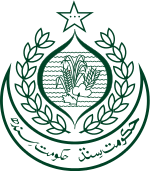 |
|
Ancient
|
|
Classical
|
|
Medieval
|
|
Colonial
|
|
Pakistan
|
| History of Pakistan |
Part of a series on the |
|---|
| History of Pakistan |
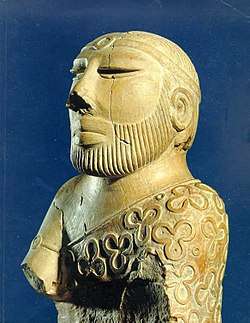 |
| Timeline |
|
Ancient
|
|
Classical
|
|
Medieval
|
|
Early modern
|
|
Modern
|
|
History of provinces |
|
The history of Sindh or Sind (Sindhi: سنڌ جي تاريخ, Urdu: سندھ کی تاریخ) is intertwined with the history of the broader Indian subcontinent and surrounding regions. Sindh was at the center of the Indus Valley civilization, one of the cradle of civilization; and currently a province of modern-day Pakistan.
Periods
Indus Valley Civilisation
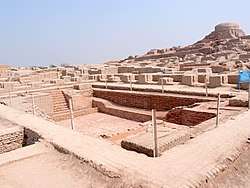
It is believed by most scholars that the earliest trace of human inhabitation in India traces to the Soan Sakaser Valley between the Indus and the Jhelum rivers. This period goes back to the first inter-glacial period in the Second Ice Age, and remnants of stone and flint tools have been found.[1]
Sindh and surrounding areas contain the ruins of the Indus Valley Civilization. There are remnants of thousand year old cities and structures, with a notable example in Sindh being that of Mohenjo Daro. Hundreds of settlements have been found spanning an area of about a hundred miles. These ancient towns and cities had advanced features such as city-planning, brick-built houses, sewage and draining systems, as well as public baths. The people of the Indus Valley also developed a writing system, that has to this day still not been fully deciphered.[2] The people of the Indus Valley had domesticated bovines, sheep, elephants, and camels. The civilization also had knowledge of metallurgy. Gold, silver, copper, tin, and alloys wre widely in use. Arts and crafts flourished during this time as well; the use of beads, seals, pottery, and bracelets are evident.[3]
Vedic Descriptions

Literary evidence from the Vedic period suggests a transition from early small janas, or tribes, to many janapadas (territorial civilizations) and gana-samgha societies. The gana samgha soceties are loosely translated to being oligarchies or republics. These political entities were represented from the Rigveda to the Astadhyayi by Pāṇini.[4] Many Janapadas were mentioned from vedic texts and are confirmed by Ancient Greek historical sources. Most of the Janapadas that had exerted large territorial influence, or mahajanapadas, had been raised in the Indo-Gangetic Plain with the exception of Gandhara in what is now Afghanistan. There was a large level of contact between all the janapadas, with descriptions being given of trading caravans, movement of students from universities, and itineraries of princes.[5]
Achaemenid Empire (Sattagydia)
Sattagydia (Old Persian Thataguš, country of the "hundred cows") was one of the easternmost satrapies of the Achaemenid Empire, situated east of the Kirthar Mountains on the Indus River, corresponding approximately to southern Indoscythia and to the current Sindh region of Pakistan. It was bounded on the west by Gedrosia, on the north by Arachosiaand on the south and east by the Mahajanapadas.
Ror dynasty
It was a power from the Indian subcontinent that ruled modern-day Sindh and northwest India from 450 BC. The Rors ruled from Rori and was built by Dhaj, Ror Kumar, a Ror Kshatriya, in the 5th century BCE. Rori has been known by names such as Roruka and Rorik since antiquity. As capital of the Sauvira Kingdom, Roruka is mentioned as an important trading center in early Buddhist literature. Buddhist Jataka stories talk about exchanges of gifts between King Rudrayan of Roruka and King Bimbisara of Magadha. Divyavadana, the Buddhist chronicle has said that Ror historically competed with Pataliputra in terms of political influence. The scholar T.W. Rhys Davids has mentioned Roruka as one of the most important cities of India in the 7th century BCE.
Sattagydia is mentioned for the first time in the Behistun inscription of Darius the Great as one of the provinces in revolt while the king was in Babylon. The revolt was presumably suppressed in 515 BCE. The satrapy disappears from sources after 480 BCE, possible being mentioned by another name or included with other regions.
Alexander the Great
Alexander conquered Sindh after Punjab. Alexander's death gave rise to Seleucid Empire which was defeated by Mauryan empire.
Mauryan Era
Chandragupta Maurya, with the aid of Kautilya, had established his empire around 320 BCE. The early life of Chandragupta Maurya is not clear. Kautilya took a young Chandragupta to the University at Taxila and enrolled him in order to educate him in the arts, sciences, logic, mathematics, warfare, and administration. Chankya's main task was to liberate India from Greek rule. With the help of the small Janapadas of Punjab and Sindh, he had went on to conquer much of the North West. He then defeated the Nanda rulers in Pataliputra to capture the throne. Chandragupta Maurya fought Alexander's successor in the east, Seleucus I Nicator, when the latter invaded. In a peace treaty, Seleucus ceded all territories west of the Indus River and offered a marriage, including a portion of Bactria, while Chandragupta granted Seleucus 500 elephants.[6]
The Mauryan rule was advanced for its time, and foreign accounts of Indian cities mention many temples, libraries, universities, gardens, and parks. A notable account was that of the Greek ambassador Megasthenes, who had visited the Mauryan capital of Pataliputra. Chandragupta's rule was a very well organized one. The Mauryans had a strong centralized government with a competent bureaucracy. This bureaucracy had concerned itself with the affairs of tax collection, trade and commerce, industrial activities, mining, statistics and data, maintenance of public places, and upkeep of temples.[6]
The Mauryan Empire was greatly weakened following the death of Ashoka. The dynasty lasted until c.184 B.C when the commander-in-chief captured the throne from Brihadratha. What remained under the power of the Mauryans was ruled by the subsequent Sunga dynasty. [7]
Greco-Bactrians
Following a century of Mauryan rule which ended by 232 BCE, the region came under the Greco-Bactrians based in what is today Afghanistan and these rulers would also convert to and proliferate Buddhism in the region. The Buddhist city of Siraj-ji-Takri is located along the western limestone terraces of the Rohri Hills in the Khairpur district of Upper Sindh, along the road that leads to Sorah. Its ruins are still visible on the top of three different mesas, in the form of stone and mud-brick walls and small mounds, whilst other architectural remains were observed along the slopes of the hills in the 1980s. This city is not mentioned from any text dealing with the history of the Buddhist period of Sindh.
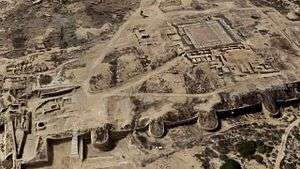
Indo Scythians
indo scythians ruled SIndh for a short period until they were thrown away by Kushans
Kushan Empire
Kushans ruled Sindh and called the land ''Scythia'' and in this period Buddhist developed in the region.Kahu-jo-Daro stupa at mirpurkhas exhibits presence of buddhist practices in Sindh.
Sassanian Empire
Sassanians overthrow Kushans in 3rd century controlled sindh until end of 5th century when they were overthrown by Gupta empire
Gupta Empire
Gupta empire controlled SIndh for a short period before they were defeated by Hephthalite or Hunas (Huns)
Rai Dynasty (c. 524–632 CE)

was a dynasty that ruled on the Indian subcontinent during the Classical period. Originating in the region of Sindh, in modern Pakistan, the dynasty at its height of power ruled much of the Northwestern regions of the Indian subcontinent. The influence of the Rais extended from Kashmir in the east, Makran and Debal port (modern Karachi) in the west, Surat port in the south, and the Kandahar, Sulaiman, Ferdan and Kikanan hills in the north. It ruled an area of over 600,000 square miles (1,553,993 km2), and the dynasty reigned a period of 143 years.
Brahman dynasty (c. 632 – c. 724 CE)
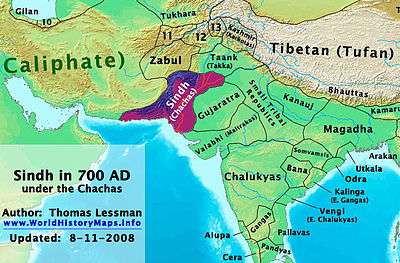
It was a Hindu power on the Indian subcontinent which originated in the region of Sindh(present-day Pakistan). Most of the information about its existence comes from the Chach Nama, a historical account of the Chach-Brahman dynasty. The Brahman dynasty were successors of the Rai dynasty. Although under Hindu kingship, buddhism was the main religion of Sindh or at least in Southern parts of SIndh.
Islamic Invasions

Arab Invasions
After the death of the Islamic prophet Muhammad, his successors contributed to the expansion of Islam over other nations. They also wanted to conquer India. Among the causes regarded to be behind the conquests are religious motivation to convert Dar al-Harb into Dar al-Islam by launching jihad. An expedition under Abdullah against Sindh failed. The cause for the launch of the conquest of Sindh was the pirate attack on Arabs by near Sindh in 711-12.[8][9]
The first clash between Arabs and the Indians took place in 636 (15 A.H.) under Umar ibn al-Khattab with the governor of Bahran, Uthman ibn Abu-al-Aas, dispatching naval expeditions against Thane and Bharuch under the command of his brother, Hakam. Another brother of his, al-Mughira, was given the command of the expedition against Debal.[10] Al-Baladhuri states they were victorious at Debal but doesn't mention the results of other two raids. However, the Chach Nama states that the raid of Debal was defeated and its governor killed the leader of the raids.[11]
Reasons for these raids are thought it be either activity of pirates as seen from a later pirate attack on Umayyad ships leading to the Arab conquest of Sindh in 711-12[9] to being plundering raids.[12] Al-Baladhuri doesn't mention any details of these expeditions. Uthman was warned by Umar against it who said "O brother of Thaqif, you have put the worm on the wood. I swear, by Allah that if they had been smitten, I would have taken the equivalent (in men) from your families." Baladhuri adds that this stopped any more incursions until the reign of Uthman.[13]
In 712, when Mohammed Bin Qasim invaded Sindh with 6000 cavalry while also receiving reinforcements. Al-Hajjaj ibn Yusuf instructed him not to spare anyone in Debal. The historian al-Baladhuri stated that after conquest of Debal, Qasim kept slaughtering its inhabitants for three days. The custodians of the Buddhist stupa were killed and the temple was destroyed. Qasim gave a quarter of the city to Muslims and built a mosque there.[14] According to the Chach Nama, after the Arabs scaled Debal's walls, the besieged denizens opened the gates and pleaded for mercy but Qasim stated he had no orders to spare anyone. No mercy was shown and the inhabitants were accordingly thus slaughtered for three days, with its temple desecrated and 700 women taking shelter there enslaved. At Raor, 6000 fighting men were massacred with their families enslaved. The massacre at Brahamanabad has various accounts of 6,000 to 26,000 inhabitants slaughtered.[15]
60,000 slaves including 30 young royal women were sent to al-Hajjaj. During the capture of one of the forts of Sindh, the women committed the jauhar and burnt themselves to death according to the Chach Nama.[15] S.A.A. Rizvi citing the Chach Nama, considers that conversion to Islam by political pressure began with Qasim's conquests. The Chach Nama has one instance of conversion, that of a slave from Debal converted at Qasim's hands.[16] After executing Sindh's ruler, Raja Dahir, his two daughters were sent to the caliph and they accused Qasim of raping them. The caliph ordered Qasim to be sewn up in hide of a cow and died of suffocation.[17]
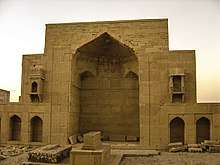
Ghaznavids
Some of the territory in Sindh found itself under raid from the Ghaznavid Empire. In 974 Pirin, the slave-governor of Ghazni, repulsed a force sent from India to seize that stronghold, then in 977 Sabuktigin, his successor, became virtually independent and founded the dynasty of the Ghaznavids. Sabuktagin's son Mahmud of Ghazni had pushed further into the subcontinent, including in Kannauj. Mahmud is viewed negatively in India for forcing Hindus and Buddhists to convert to Islam while destroying and looting Hindu temples. The primary motivation of his raids were the destruction and looting of Hindu temples, with examples being that of Somnath temple and the temples at Mathura.[18][19]
Mughals
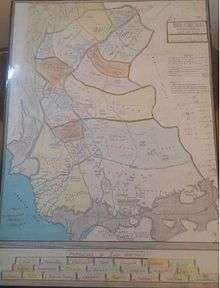
Dynasties came and went for several hundred years until 1520, when sindh was brought into the Mughal Empire by Akbar, himself born in Umerkot in Sindh. Mughal rule from their provincial capital of Thatta was to last in lower Sindh until the early 18th century. Upper Sindh was a different picture, however, with the indigenous Kalhora dynasty holding power, consolidating their rule until the mid-18th century, when the Persian sacking of the Mughal throne in Delhi allowed them to grab the rest of Sindh. Akbar unlike his predecessors, was renowned for his religious freedom.
Early in his reign in 1563, the emperor abolished taxes on Hindu pilgrims and allowed Hindu temples to be built and repaired. In 1564 he abolished the jizya, the tax paid by all dhimmis.
Modern era
The British conquered Sindh in 1843. General Charles Napier is said to have reported victory to the Governor General with a one-word telegram, namely "Peccavi" – or "I have sinned" (Latin). In fact, this pun first appeared as a cartoon in Punch magazine. The British had two objectives in their rule of Sindh: the consolidation of British rule and the use of Sindh as a market for British products and a source of revenue and raw materials. With the appropriate infrastructure in place, the British hoped to utilise Sindh for its economic potential.[20]
The British incorporated Sindh, some years later after annexing it, into the Bombay Presidency. Distance from the provincial capital, Bombay, led to grievances that Sindh was neglected in contrast to other parts of the Presidency. The merger of Sindh into Punjab province was considered time from time but was turned down because of British disagreement and Sindhi opposition, both from Muslims and Hindus, to being annexed to Punjab.[20]
The British desired to increase their profitability from Sindh and carried out extensive work on the irrigation system in Sindh, for example the Jamrao Canal project. However, the local Sindhis were described as both eager and lazy and for this reason the British authorities encouraged the immigration of Punjabi peasants into Sindh as they were deemed more hard-working. Punjabi migrations to Sindh paralleled the further development of Sindh’s irrigation system in the early 20th century. Sindhi apprehension of a ‘Punjabi invasion’ grew.[20]
In his backdrop, desire for a separate administrative status for Sindh grew. At the annual session of the Indian National Congress in 1913, a Sindhi Hindu put forward the demand for Sindh’s separation from the Bombay Presidency on the grounds of Sindh’s unique cultural character. This reflected the desire of Sindh’s predominantly Hindu commercial class to free itself from competing with the more powerful Bombay’s business interests.[20] Meanwhile, Sindhi politics was characterised in the 1920s by the growing importance of Karachi and the Khilafat Movement.[21] A number of Sindhi pirs, descendants of Sufi saints who had proselytised in Sindh, joined the Khilafat Movement, which propagated the protection of the Ottoman Caliphate, and those pirs who did not join the movement found a decline in their following.[22] The pirs generated huge support for the Khilafat cause in Sindh.[23] Sindh came to be at the forefront of the Khilafat Movement.[24]
Although Sindh had a cleaner record of communal harmony than other parts of India, the province’s Muslim elite and emerging Muslim middle class demanded separation of Sindh from Bombay Presidency as a safeguard for their own interests. In this campaign local Sindhi Muslims identified ‘Hindu’ with Bombay instead of Sindh. Sindhi Hindus were seen as representing the interests of Bombay instead of the majority of Sindhi Muslims. Sindhi Hindus, for the most part, opposed the separation of Sindh from Bombay.[20] Sindh’s Hindu and Muslim communities lived in close proximity to each other and extensively influenced each other’s culture. Scholars have discussed that it was found that Hindu practices in Sindh differed from orthodox Hinduism in the rest of India. Hinduism in Sindh was to a large extent influenced by Islam, Sikhism and Sufism. Sindh’s religious syncretism was a result of Sufism. Sufism was a vital component of Sindhi Muslim identity and Sindhi Hindus, more than Hindus in any other part of India, came under the influence of Sufi thought and practices and the majority of them were murids (followers) of Sufi Muslim saints.[25]
However, both the Muslim landed elite, waderas, and the Hindu commercial elements, banias, collaborated in oppressing the predominantly Muslim peasantry of Sindh who were economically exploited. In Sindh’s first provincial election after its separation from Bombay in 1936, economic interests were an essential factor of politics informed by religious and cultural issues.[26] Due to British policies, much land in Sindh was transferred from Muslim to Hindu hands over the decades.[27] Religious tensions rose in Sindh over the Sukkur Manzilgah issue where Muslims and Hindus disputed over an abandoned mosque in proximity to an area sacred to Hindus. The Sindh Muslim League exploited the issue and agitated for the return of the mosque to Muslims. Consequentially, a thousand members of the Muslim League were imprisoned. Eventually, due to panic the government restored the mosque to Muslims.[26]
The separation of Sindh from Bombay Presidency triggered Sindhi Muslim nationalists to support the Pakistan Movement. Even while the Punjab and North-West Frontier Province were ruled by parties hostile to the Muslim League, Sindh remained loyal to Jinnah.[28] Although the prominent Sindhi Muslim nationalist G.M. Syed left the All India Muslim League in the mid-1940s and his relationship with Jinnah never improved, the overwhelming majority of Sindhi Muslims supported the creation of Pakistan, seeing in it their deliverance.[21] Sindhi support for the Pakistan Movement arose from the desire of the Sindhi Muslim business class to drive out their Hindu competitors.[29] The Muslims League’s rise to becoming the party with the strongest support in Sindh was in large part linked to its winning over of the religious pir families. Although the Muslim Leaue had previously fared poorly in the 1937 elections in Sindh, when local Sindhi Muslim parties won more seats,[30] the Muslim League’s cultivation of support from the pirs and saiyids of Sindh in 1946 helped it gain a foothold in the province.[31]
In 1947, violence did not constitute a major part of the Sindhi partition experience, unlike in Punjab. There were very few incidents of violence on Sindh, in part due to the Sufi-influenced culture of religious tolerance and in part that Sindh was not divided and was instead made part of Pakistan in its entirety. Sindhi Hindus who left generally did so out of a fear of persecution, rather than persecution itself, because of the arrival of Muslim refugees from India. Sindhi Hindus differentiated between the local Sindhi Muslims and the migrant Muslims from India. A large number of Sindhi Hindus travelled to India by sea, to the ports of Bombay, Porbandar, Veraval and Okha.[32]
References
- ↑ Singh, Mohinder. History and Culture of Panjab. Atlantic Publishers. p. 1.
|access-date=requires|url=(help) - ↑ Singh, Mohinder. History and Culture of Panjab. Atlantic Publishers. pp. 2–3.
|access-date=requires|url=(help) - ↑ Panikkar, K.M (1966). A Survey of Indian History. Asia Publishing House.
|access-date=requires|url=(help) - ↑ Chattopadhyaya, Brajadulal (2003). Studying Early India: Archaeology, Texts, and Historical Issues. Permanent Black Publishers. p. 55. ISBN 81-7824-143-9.
- ↑ Chattopadhyaya, Brajadulal (2003). Studying Early India: Archaeology, Texts, and Historical Issues. Permanent Black Publishers. pp. 56–57. ISBN 81-7824-143-9.
- 1 2 Thorpe, p. 33.
- ↑ Chaurasia, p. 126.
- ↑ Tandle, pp. 269, 270.
- 1 2 El Hareir, Idris; Mbaye, Ravane (2012). The Spread of Islam Throughout the World. UNESCO. p. 602. ISBN 978-92-3-104153-2.
- ↑ El Hareir, Idris; Mbaye, Ravane (2012). The Spread of Islam Throughout the World. UNESCO. pp. 601–2. ISBN 978-92-3-104153-2.
- ↑ Majumdar, Ramesh Chandra (1976). Readings in political history of India, ancient, mediaeval, and modern. B.R. Pub. Corp., on behalf of Indian Society for Prehistoric and Quaternary Studies. p. 216.
- ↑ Tripathi, Rama Shankar (1967). History of Ancient India. Motilal Banarsidass Publ. p. 337. ISBN 978-81-208-0018-2.
- ↑ Asif, Manan Ahmed (2016). A Book of Conquest. Harvard University Press. p. 35. ISBN 978-0-674-66011-3.
- ↑ Wink, André (2002). Al-Hind, the Making of the Indo-Islamic World: Early Medieval India and the Expansion of Islam 7Th-11th Centuries. BRILL. p. 203. ISBN 0-391-04173-8.
- 1 2 The Classical age, by R. C. Majumdar, p. 456
- ↑ Asif, Manan Ahmed (2016). A Book of Conquest. Harvard University Press. p. 117. ISBN 978-0-674-66011-3.
- ↑ Suvorova, Anna (2004). Muslim Saints of South Asia: The Eleventh to Fifteenth Centuries. Routledge. p. 218. ISBN 978-1-134-37006-1.
- ↑ Panikkar, p. 115.
- ↑ Wynbrandt, p. 52-55.
- 1 2 3 4 5 Roger D. Long; Gurharpal Singh; Yunas Samad; Ian Talbot (8 October 2015). State and Nation-Building in Pakistan: Beyond Islam and Security. Routledge. pp. 102–. ISBN 978-1-317-44820-4.
- 1 2 I. Malik (3 June 1999). Islam, Nationalism and the West: Issues of Identity in Pakistan. Palgrave Macmillan UK. pp. 56–. ISBN 978-0-230-37539-0.
- ↑ Gail Minault (1982). The Khilafat Movement: Religious Symbolism and Political Mobilization in India. Columbia University Press. pp. 105–. ISBN 978-0-231-05072-2.
- ↑ Sarah F. D. Ansari (31 January 1992). Sufi Saints and State Power: The Pirs of Sind, 1843-1947. Cambridge University Press. pp. 77–. ISBN 978-0-521-40530-0.
- ↑ Pakistan Historical Society (2007). Journal of the Pakistan Historical Society. Pakistan Historical Society. p. 245.
- ↑ Priya Kumar & Rita Kothari (2016) Sindh, 1947 and Beyond, South Asia: Journal of South Asian Studies, 39:4, 775, DOI: 10.1080/00856401.2016.1244752
- 1 2 Ayesha Jalal (4 January 2002). Self and Sovereignty: Individual and Community in South Asian Islam Since 1850. Routledge. pp. 415–. ISBN 978-1-134-59937-0.
- ↑ Amritjit Singh; Nalini Iyer; Rahul K. Gairola (15 June 2016). Revisiting India's Partition: New Essays on Memory, Culture, and Politics. Lexington Books. pp. 127–. ISBN 978-1-4985-3105-4.
- ↑ Khaled Ahmed (18 August 2016). Sleepwalking to Surrender: Dealing with Terrorism in Pakistan. Penguin Books Limited. pp. 230–. ISBN 978-93-86057-62-4.
- ↑ Veena Kukreja (24 February 2003). Contemporary Pakistan: Political Processes, Conflicts and Crises. SAGE Publications. pp. 138–. ISBN 978-0-7619-9683-5.
- ↑ Sarah F. D. Ansari (31 January 1992). Sufi Saints and State Power: The Pirs of Sind, 1843-1947. Cambridge University Press. pp. 115–. ISBN 978-0-521-40530-0.
- ↑ Sarah F. D. Ansari (31 January 1992). Sufi Saints and State Power: The Pirs of Sind, 1843-1947. Cambridge University Press. pp. 122–. ISBN 978-0-521-40530-0.
- ↑ Priya Kumar & Rita Kothari (2016) Sindh, 1947 and Beyond, South Asia: Journal of South Asian Studies, 39:4, 776-777, DOI: 10.1080/00856401.2016.1244752
Sources
- "A Survey Of Indian History K. M. Panikkar". 15 August 1947. Missing or empty
|url=(help);|access-date=requires|url=(help) - Tandle, S. Indian History. Laxmi Book Publications. ISBN 978-1-312-37211-5.
- Wynbrandt, James (2009). A Brief History of Pakistan. New York: Infobase Publishing.
|access-date=requires|url=(help) - Thorpe, Showick; Thorpe, Edgar (2009). The Pearson General Studies Manual 2009, 1/e. Pearson. ISBN 978-81-317-2133-9.
- Chaurasia, R.S. (2002). History of Ancient India: Earliest Times to 1000 A. D. Atlantic Publishers & Distributors (P) Limited. ISBN 978-81-269-0027-5.
- Kazi, M.A. (1990). Journey Through Judiciary. Royal Book Company. Retrieved 2018-04-27.
.jpg)